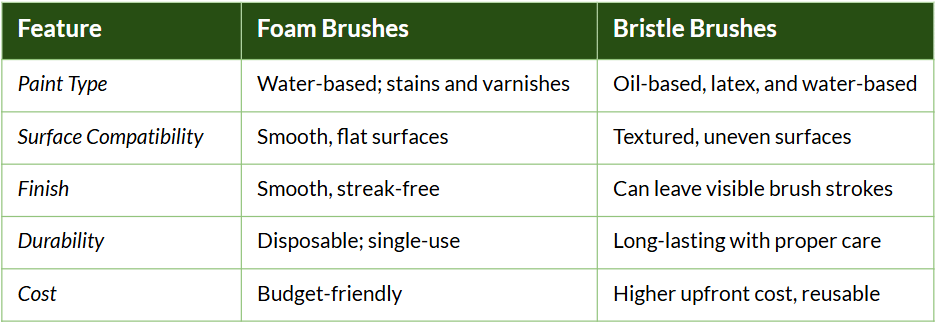House paint isn’t cheap, so why would you skimp on your paintbrushes?
Professional painters know that the quality of the brush makes a huge difference. They also know that the cheapest brush is sometimes the best for the job.
Say what?
That’s right — for certain tasks, an el cheapo disposable foam brush can provide a better finish than the finest natural bristle brush that costs nearly as much as a house payment.
Each type of brush has unique pros and cons, depending on the project. Let’s dig into the details so you can confidently choose the right brush for your next painting endeavor.
Foam Brushes: The Affordable Choice
Foam brushes have a foam head attached to a wooden or plastic handle. They’re available in different sizes and shapes to fit into corners and crannies.
They provide smooth and even coverage on smooth surfaces like walls, doors, and trim. Their softness allows them to flex with the surface, leaving behind no brush marks or streaks.
Foam brushes work best with water-based paints, stains, and finishes.
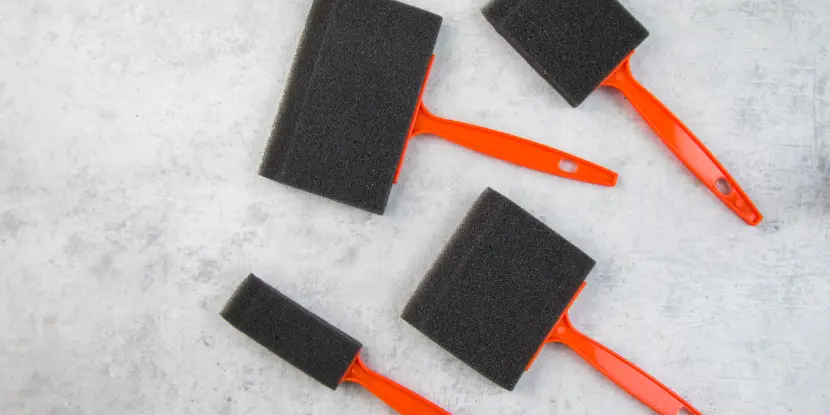
Foam brushes come in various sizes and shapes for different jobs. Often, you can buy them in multipacks.
Advantages of Foam Brushes
- Smooth Application: Foam brushes deliver a smooth finish without visible brush strokes, making them ideal for varnishes and stains.
- Lightweight: They’re easy to handle, even for beginners.
- Cost-Effective: Foam brushes are cheap and often sold in bulk, making them perfect for quick, one-time-use projects.
- No Bristles to Shed: Unlike bristle brushes, they don’t leave stray bristles in your wet paint.
Disadvantages of Foam Brushes
- Limited Lifespan: Foam brushes wear out quickly, especially during lengthy or high-abrasion projects.
- Lackluster Performance on Uneven Surfaces: They struggle with textured or rough surfaces, as the foam doesn’t conform like bristles.
- Poorly Suited for Oils: Oil-based paints can break down the foam, reducing its life.
Best Uses for Foam Brushes
- Applying wood stains or varnishes
- Touching up or crafting small projects
- Smooth, flat surfaces like furniture, cabinets, or paneling
Bristle Brushes: The Durable Choice
Bristle brushes, made from natural or synthetic hair, come in various shapes, sizes, and stiffness levels. When properly cared for, high-quality brushes can last for years.
These brushes offer more control than foam brushes, making them ideal for precision work or creating texture. They also work with any type of paint — oil-based or water-based.
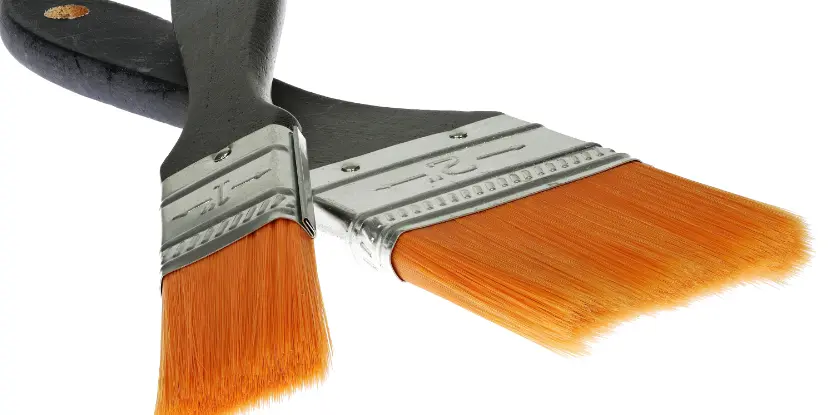
Always invest in quality paintbrushes for a professional finish.
Advantages of Bristle Brushes
- Versatility: Suitable for water-based, oil-based, and latex paints.
- Great for Texture: They can easily reach into corners, textures, and uneven surfaces.
- Durable and Reusable: With proper cleaning and care, they can be reused for years.
- Even Coverage: They provide full coverage and can hold more paint.
Disadvantages of Bristle Brushes
- Visible Brush Strokes: Unlike foam brushes, bristle brushes can leave stroke marks, especially if used haphazardly.
- Shedding: Lower-quality brushes may shed bristles into your paintwork, marring the finish.
- Higher Price Tag: High-quality bristle brushes cost much more than foam brushes.
Best Uses for Bristle Brushes
- Wall painting and cutting along edges
- Textured surfaces such as wood grain or concrete
- Applying oil-based paints and heavier coatings
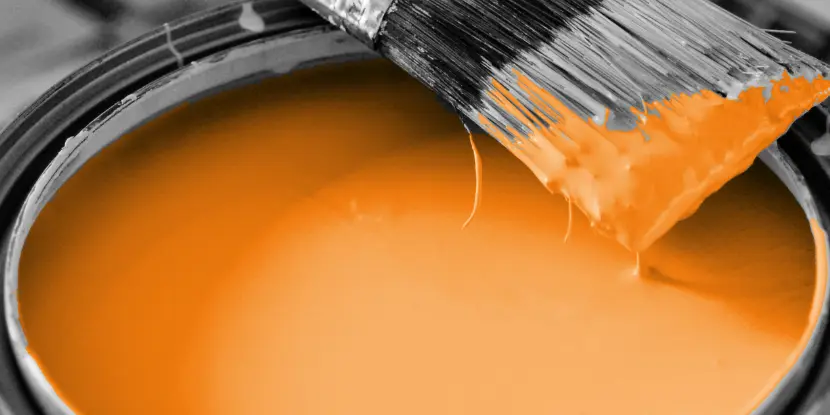
Bristle brushes can hold more paint than foam brushes.
Key Differences Between Foam & Bristle Brushes
Choosing the Right Brush for Your Project
1. Type of Paint or Finish
- Foam brushes work best with water-based finishes or thin substances like varnish and stain.
- Bristle brushes handle thicker oil-based paints, latex, or acrylics with ease.

A bristle brush is best for uneven surfaces like wood or stucco.
2. Surface Texture
- Foam brushes ensure a clean, uniform finish when painting smooth, flat surfaces like a tabletop or trim.
- Textured or uneven surfaces such as walls or outdoor furniture often require a bristle brush to navigate grooves and irregularities.
3. Desired Finish
- Choose foam brushes for smooth, streak-free results.
- Opt for bristle brushes to achieve an even coat over an irregular surface — texture is no issue.
4. Project Scale
- For quick, small projects or crafts, foam brushes are inexpensive and disposable.
- For larger, intensive tasks like repainting a hallway or a piece of outdoor furniture, invest in a high-quality bristle brush.
5. Budget
- Foam brushes are perfect for single-use applications.
- Bristle brushes are more of an investment, but they last longer, ultimately saving you money on repeat purchases.

Clean your paintbrushes immediately after use. Latex paint washes out with soap and water.
Pro Tip for Superior Painting Results
Regardless of the brush you choose, preparation is key to professional results:
- Clean the surface before painting to remove dirt and grease.
- Invest in quality paint for easier application and longer-lasting finishes.
- Use painter’s tape for clean edges and reduced mess.
- Test the brush on a scrap piece to verify it’s the right choice for your paint and surface type.
Bonus tip: If you’re torn between the two brushes, keep both types on hand. You may want to start broad areas with a bristle brush and switch to a foam brush for detail work and smooth finishes.
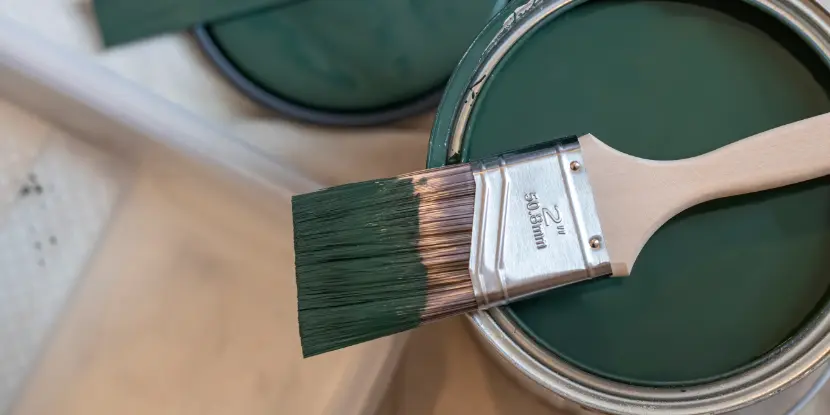
Won’t that hunter-green dining room look fabulous once you’ve painted the contrasting trim!
FAQs: Foam Vs. Bristle Paint Brushes
Q: How do I clean and care for my brushes?
Foam brushes should be disposed of after use, while bristle brushes require proper cleaning with warm water and mild soap. After rinsing, comb out the excess paint from the brush, reshape it with your fingers, and store it in a dry place.
Q: How can I avoid visible brush strokes?
Choose a high-quality bristle or foam brush appropriate for your surface and paint type. Use smooth, steady strokes and avoid overworking an area. Consider using a roller or sprayer for larger surfaces.
Q: Can I reuse foam brushes, or are they disposable?
Foam brushes are typically single-use and should not be reused. They’re affordable and perfect for small projects.
Q: Can I use a foam brush for oil-based paints?
Foam brushes are poorly suited for oil-based paints. The oils can degrade the foam, causing it to break apart during use. It’s better to use a bristle brush to ensure proper application.
Q: What size brush should I use for detailed work?
Choose a smaller brush, such as a 1-inch bristle brush, for precise control. Foam brushes can also work for smaller areas if you need a smooth finish, but bristle brushes offer greater versatility for fine details.
Q: How do I prevent bristles from shedding into my paint?
Invest in high-quality bristle brushes. Before painting, try running your hand over the brush to remove any loose bristles. Proper care and cleaning after each use will help maintain the brush’s integrity.
Q: Are there alternatives to brushes for painting?
Alternatives include paint rollers and sprayers. Rollers are ideal for quickly covering large, flat areas, while sprayers achieve an even coat on intricate or textured surfaces. However, brushes are still the best choice for detailed or controlled applications.
Q: How do I choose the right stiffness for bristle brushes?
The stiffness of a bristle brush depends on the project and paint type. Stiff bristles are ideal for thicker paints and rough surfaces, while softer bristles work better with thinner paints and delicate surfaces. Check the brush packaging for recommended uses.


